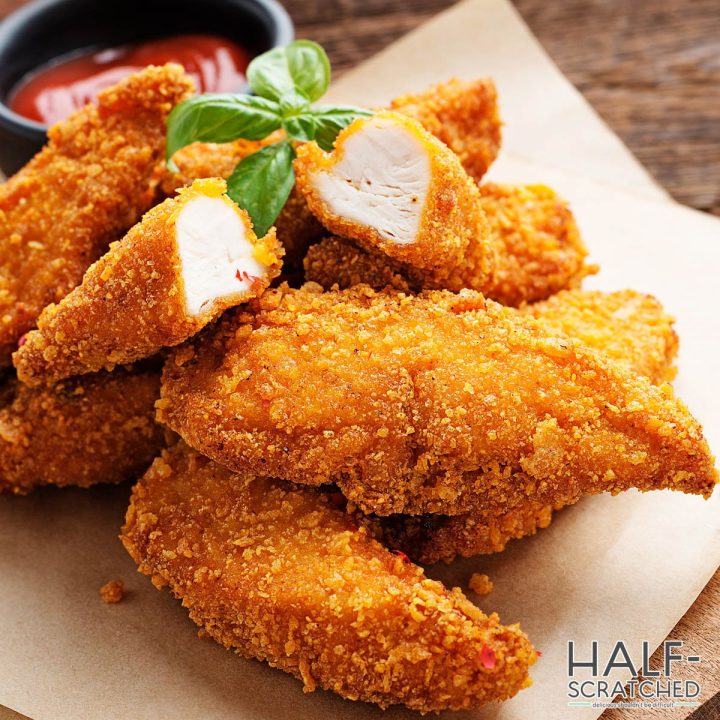Chicken tenders (chicken fingers) are a family-friendly meal that children and grown-ups alike can enjoy. So, if you’re looking for an easy and tasty meal, chicken tenders are a great option!
Cooking them in the oven is a simple way to ensure they’re cooked to perfection. But if you’re wondering how long to bake chicken tenders at 400 Fahrenheit, you’ve come to the right place.

Baking chicken tenders at 400 degrees Fahrenheit is a great way to get a crispy exterior with a juicy interior. Depending on the size of the tenders, you can expect to bake them for 20-25 minutes. But that’s not the whole story. It’s also important to consider whether or not you’ll be using aluminum foil or breading to help the chicken tenders cook more evenly.
In this article, we’ll discuss everything you need to know to make delicious homemade chicken fingers without fault. We’ll cover several considerations for how to prepare the meat, including the effects of aluminum foil and breading, as well as tips and tricks to make a delicious recipe. No matter what your preferences are, there’s something here for everyone. So, let’s get started!
Don’t Bake Below 400° Fahrenheit if You Want Crispy Tenders
Chicken tenders are known for their distinctively crispy exteriors that are often akin to classically fried cuts of chicken. This is usually achieved by battering, breading, and then deep frying the tenders, but if you’re trying to watch your cholesterol, baking is a healthier and more delicious way to get a similar result. When baking chicken tenders, though, the oven temperature is one of the most important considerations.
Baking them at a temperature lower than 400° Fahrenheit will result in soggy, limp tenders, whereas a higher temperature will give you that iconic crispy, crunchy texture. For this reason, it’s important to make sure you bake your tenders at nothing less than 400° Fahrenheit.
It’s also important to note that the cooking time is based on the size and thickness of the chicken tenders. If the tenders are thicker, they may need more time in the oven. On the other hand, thinner tenders may require less time. Most commercially bought tenders are uniform in size, though, so the variation in time shouldn’t be more than a few minutes in either direction.

The Batter Breading Technique vs. Plain Breading
When it comes to baking chicken tenders, there are two popular methods: batter breading and plain breading. Each method has its own pros and cons, so it’s important to consider which one will work best for your recipe.
The batter and breading technique involves coating the tenders with a mixture of flour, egg, and milk and then dipping the tenders in a mixture of breadcrumbs and seasonings like garlic powder, salt, and pepper. This method creates a crunchy, flavorful crust that is sure to please everyone at the table. The downside to this method is that it can be time-consuming and messy.
Alternatively, you can opt for the plain breading method. This involves simply coating the tenders in a mixture of breadcrumbs and seasonings and then baking them in the oven. This method is much simpler and can be less messy, but the downside is that it won’t produce the same thick, crunchy crust as the batter and breading technique.
Never Cover Breaded Foods with Foil
Although it’s common to cover roasted meats, casseroles, and other dishes with aluminum foil while baking, this is not recommended when baking chicken tenders. If a chicken tender is covered with aluminum foil, the tenders will not get the crispiness that is desired.
The foil prevents the heat from reaching all sides of the chicken, trapping air and steam against the meat, and leaving it soggy and chewy. Furthermore, the foil will also keep any breading from crisping up, resulting in a bland, flavorless dish. So, if you’re looking for the crispiest tenders possible, it’s best to avoid using aluminum foil.
How Long to Bake Chicken Tenders in an Air Fryer
If you don’t have an oven or if you’re looking for a quicker way to cook your chicken tenders, an air fryer can be a great option. Air fryers are great for cooking food quickly without needing to use oil. When using an air fryer, you can expect to cook your chicken tenders in about 10-15 minutes.
The meat and breading will cook faster in an air fryer because the inner chamber circulates hot air around the food. This helps to crisp the exterior of the chicken tenders while also making sure that they are cooked through.
When using an air fryer, though, it’s important to keep in mind that the cooking times may vary depending on the size and thickness of the tenders. For this reason, it’s best to check the tenders regularly to ensure that they are cooked to perfection.

Check the Internal Temperature to Gauge Doneness
When baking chicken tenders, it’s important to check the internal temperature to make sure that they are cooked through. Ideally, chicken should cook until the internal temperature reaches a minimum of 165 degrees Fahrenheit. Any less and you risk contamination and food poisoning. Anything past 170, though, and your tenders will become dry and unpleasant.
To check the internal temperature, use a food thermometer to take the temperature of the thickest part of the chicken tender. Once the chicken is done cooking, remove it from the oven and let it rest for at least 5 minutes. This will allow the juices to redistribute throughout the meat, helping to create a tender and delicious piece of chicken.
Top Tips for Home Chefs Preparing Chicken Tenders
Although these tips won’t help the chicken to bake any faster, they can help you create a delicious and unforgettable meal. Try them out as you see fit, and don’t be afraid to experiment with different flavors or spices.
Soak the Tenders in Buttermilk Before Breading
Chicken tenders are usually a quick and easy weeknight meal, but if you have a bit of extra time and want to create a melt-in-your-mouth tender cut of meat, we recommend soaking the tenders in buttermilk for at least an hour before breading them. Buttermilk is slightly acidic, which means it helps to tenderize the meat and create a delicious flavor.
Use a Mixture of Breadcrumbs; Panko
For a light and crispy crust, we recommend using a combination of breadcrumbs and Panko. Panko is made from larger, flakier crumbs, which will create a uniquely crunchy texture. Simply mix the two types of breading at a ratio of 2 parts breadcrumbs to 1 part Panko. If you’re also battering your tenders, add the breadcrumb/Panko mixture to the batter before coating the chicken.
Add Spices to the Breadcrumb Mixture
For a bit of extra flavor, try adding spices to your breadcrumb mixture. We suggest adding a teaspoon of garlic powder, a teaspoon of onion powder, and a teaspoon of paprika to the breadcrumb mixture. This will give your chicken tenders a unique kick of flavor that everyone will love. To get even more exotic, you can use curry powder, Baharat, or even an Italian herb and parmesan mix.
Use a Baking Rack, Not a Sheet
To get the crispiest chicken tenders possible, we suggest using a baking rack instead of a sheet. Baking racks are elevated, which allows the hot air to circulate evenly around the chicken and create a golden-brown crust. If you don’t have a baking rack, you can use a sheet, but make sure to flip the tenders halfway through baking.
Don’t Forget to Make a Side Sauce
Last but not least, don’t forget to make a side sauce for your chicken tenders. A honey mustard dip or a simple garlic aioli are both great accompaniments that are sure to please. If you don’t have the ingredients to make your own honey mustard, store-bought is also fine.

Frequently Asked Questions About Chicken Tenders
Yes, you can use other types of breadcrumbs, such as Italian-style or whole wheat. Keep in mind that the baking time may vary slightly depending on the type of breadcrumbs used, so be sure to watch that they don’t burn.
Yes, you can bake chicken tenders without breading or battering them. Just make sure to season the chicken tenders with your favorite spices and seasonings before baking. They won’t develop a crispy exterior but they can work as a good stand-in for chicken breasts.
Yes, you can use other types of oil, such as vegetable oil or canola oil. Just make sure to adjust the amount you use depending on the type of oil used. Vegetable and canola oils tend to be more viscous than olive oil, so you may not need as much.
Yes, you can bake chicken tenders in an air fryer. Just make sure to set the temperature to 400° Fahrenheit or higher and adjust the cooking time depending on the size and thickness of the chicken tenders.
Yes, you can freeze the cooked chicken tenders. Just make sure to let them cool completely before transferring them to an airtight container or freezer bag. When reheating the tenders, place them directly in the oven at 400 degrees Fahrenheit for roughly 20 minutes or until warmed through.
My Recipe for Perfectly Crispy Baked Chicken Tenders
These crispy baked chicken tenders are perfect for a weeknight dinner or snack. They’re easy to make and are sure to please the whole family!

How Long to Bake Chicken Tenders at 400 F
These crispy baked chicken tenders are perfect for a weeknight dinner or snack. They’re easy to make and are sure to please the whole family!
Ingredients
- 1 pound chicken tenders
- ½ cup breadcrumbs
- ½ cup Panko breadcrumbs
- 1 teaspoon garlic powder
- 1 teaspoon onion powder
- 1 teaspoon paprika
- ½ teaspoon black pepper
- ½ teaspoon salt
- 2 tablespoons olive oil
Instructions
- Preheat your oven to 400° Fahrenheit and coat a well-cleaned baking raking with baking spray.
- In a shallow bowl, mix together the breadcrumbs, panko breadcrumbs, garlic powder, onion powder, paprika, black pepper, and salt.
- Drizzle the olive oil over the chicken tenders and toss the meat until completely coated.
- Working in batches, dip the chicken tenders in the breadcrumb mixture until they are completely coated.
- Place the chicken tenders on the prepared baking rack and bake for 20-25 minutes, or until golden brown and cooked through.
- Serve with your favorite dipping sauce and enjoy!
Nutrition Information:
Yield: 2 Serving Size: 1Amount Per Serving:Calories: 1031Total Fat: 54gSaturated Fat: 9gTrans Fat: 0gUnsaturated Fat: 40gCholesterol: 104mgSodium: 2741mgCarbohydrates: 86gFiber: 5gSugar: 4gProtein: 51g


Leave a Reply